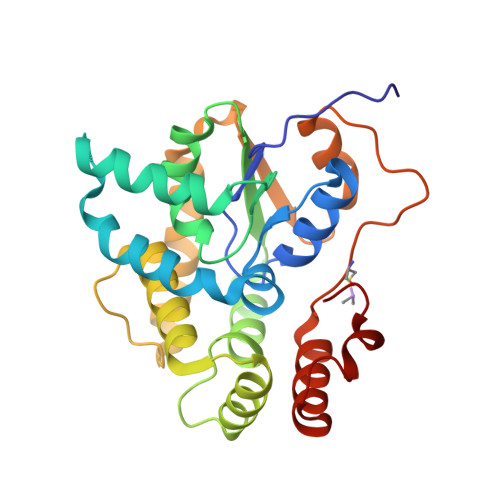Structural and Functional Characterization of the Enantiomers of the Antischistosomal Drug Oxamniquine.
Taylor, A.B., Pica-Mattoccia, L., Polcaro, C.M., Donati, E., Cao, X., Basso, A., Guidi, A., Rugel, A.R., Holloway, S.P., Anderson, T.J., Hart, P.J., Cioli, D., LoVerde, P.T.(2015) PLoS Negl Trop Dis 9: e0004132-e0004132
- PubMed: 26485649
- DOI: https://doi.org/10.1371/journal.pntd.0004132
- Primary Citation of Related Structures:
5BYJ, 5BYK - PubMed Abstract:
For over two decades, a racemic mixture of oxamniquine (OXA) was administered to patients infected by Schistosoma mansoni, but whether one or both enantiomers exert antischistosomal activity was unknown. Recently, a ~30 kDa S. mansoni sulfotransferase (SmSULT) was identified as the target of OXA action. Here, we separate the OXA enantiomers using chromatographic methods and assign their optical activities as dextrorotary [(+)-OXA] or levorotary [(-)-OXA]. Crystal structures of the parasite enzyme in complex with optically pure (+)-OXA and (-)-OXA) reveal their absolute configurations as S- and R-, respectively. When tested in vitro, S-OXA demonstrated the bulk of schistosomicidal activity, while R-OXA had antischistosomal effects when present at relatively high concentrations. Crystal structures R-OXA•SmSULT and S-OXA•SmSULT complexes reveal similarities in the modes of OXA binding, but only the S-OXA enantiomer is observed in the structure of the enzyme exposed to racemic OXA. Together the data suggest the higher schistosomicidal activity of S-OXA is correlated with its ability to outcompete R-OXA binding the sulfotransferase active site. These findings have important implications for the design, syntheses, and dosing of new OXA-based antischistosomal compounds.
- Departments of Biochemistry, the University of Texas Health Science Center, San Antonio, Texas, United States of America; X-ray Crystallography Core Laboratory, the University of Texas Health Science Center, San Antonio, Texas, United States of America.
Organizational Affiliation:




















